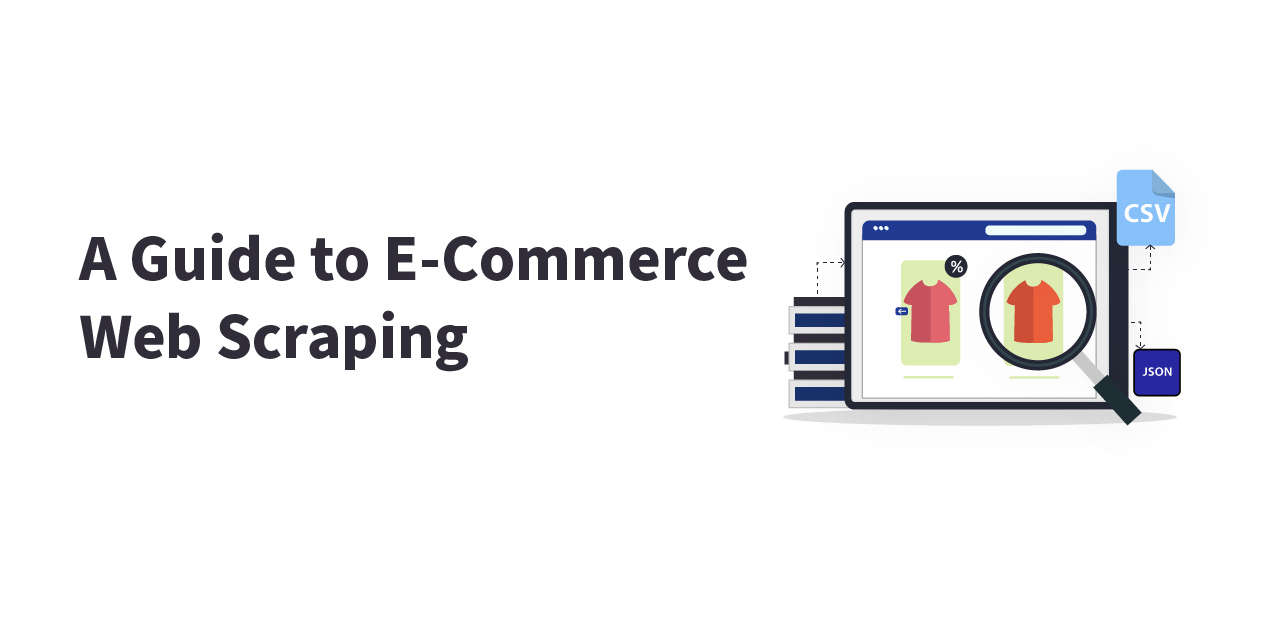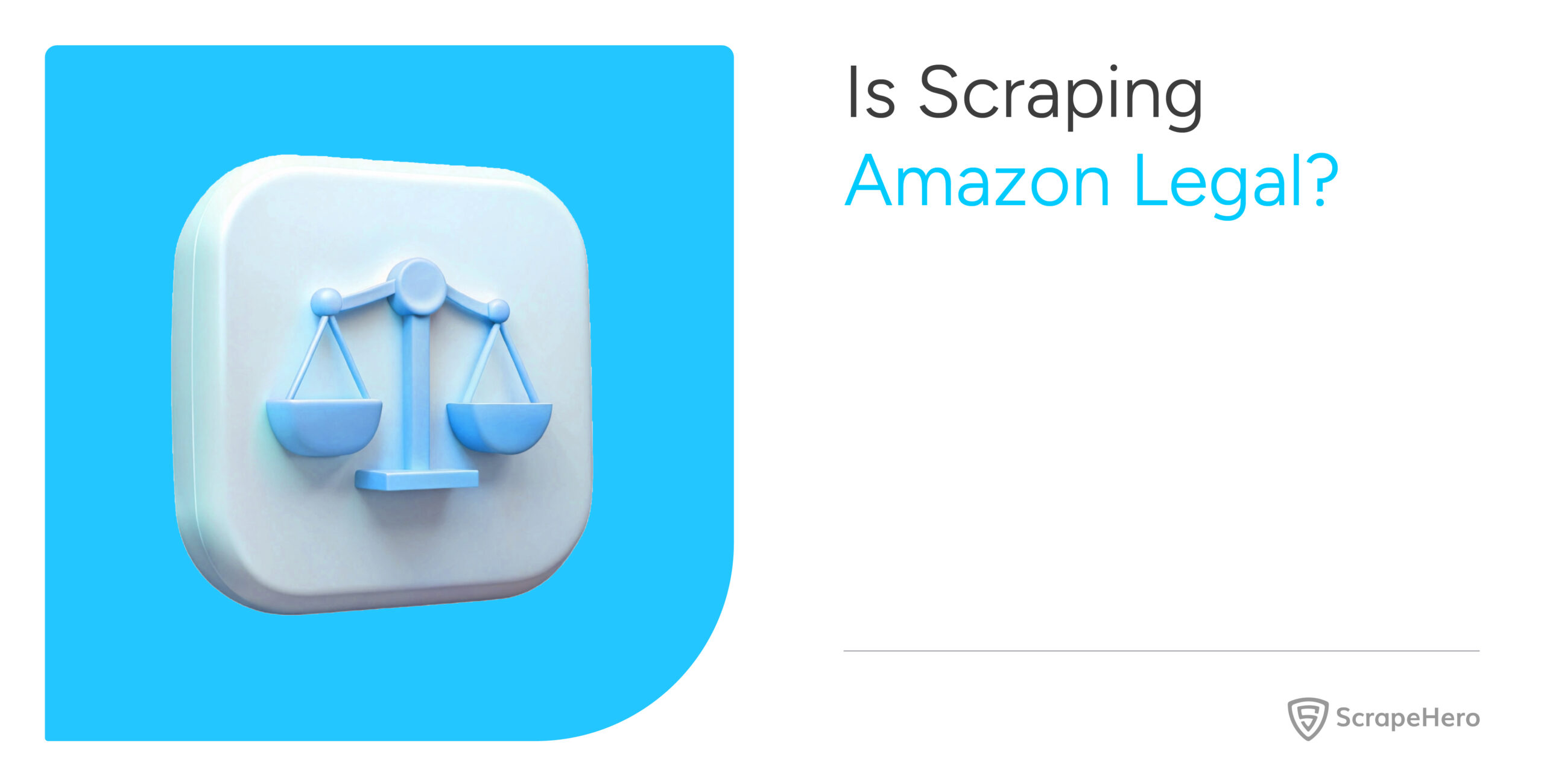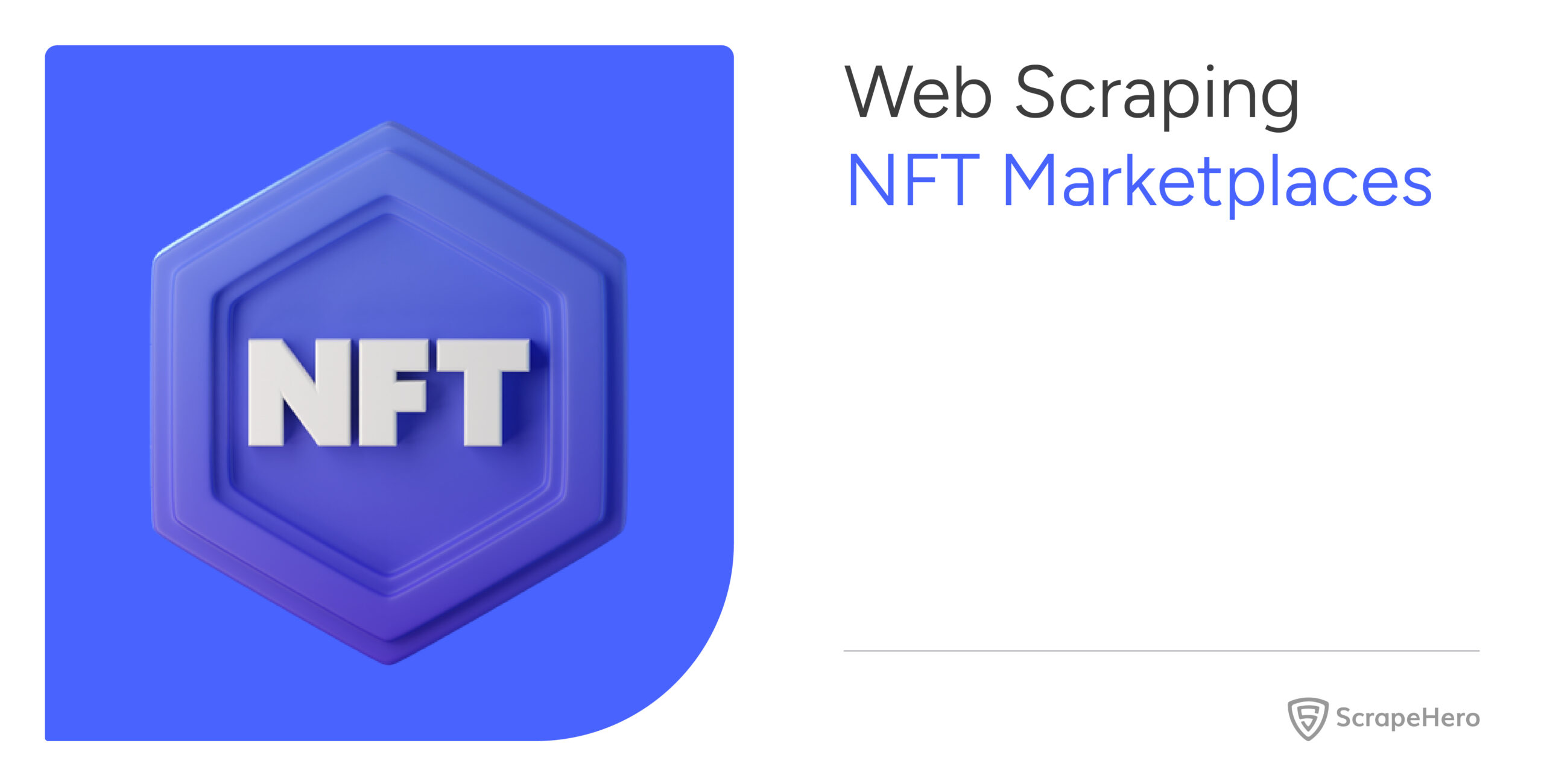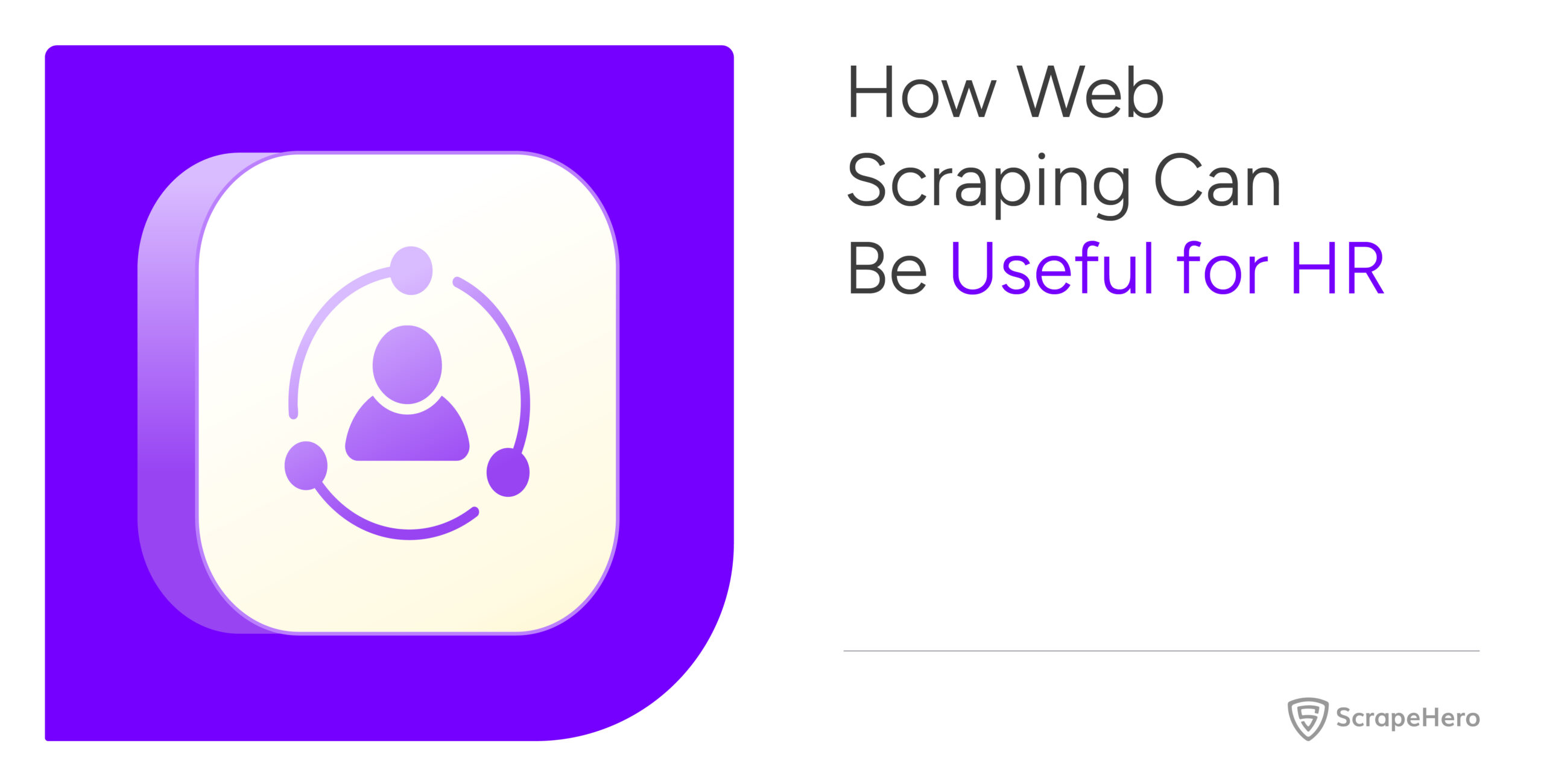Ever feel like the e-commerce landscape changes at lightning speed? You’re certainly not alone. In this digital era, the online retail world is continuously evolving, with new technologies emerging, consumer preferences shifting, and competitive tactics rapidly adapting. Staying ahead in this dynamic environment is a challenge for many businesses. This rapid pace of change demands agility and innovation from retailers, marketers, and strategists alike.
To remain competitive, businesses are using advanced tools like web scraping to gather crucial market insights, monitor competitor strategies, and understand evolving customer needs. Scraping e-commerce websites involves collecting data from online stores.
It allows you to keep an eye on all the competitors and quickly grabs prices, product features, reviews, and other relevant information from multiple websites. This will help make better decisions, from setting competitive prices to choosing which products to stock. In e-commerce, knowing your competitors’ moves can set you apart.
Say Goodbye to Guesswork!
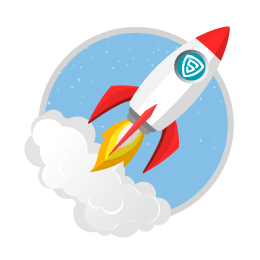
Web Scraping and E-Commerce Web Scraping
Gathering information from the web manually can be a labor-intensive and time-consuming process. It involves visiting numerous websites, one by one, and meticulously extracting relevant data. This task requires not only a significant amount of time but also sustained attention to detail.
The process can be particularly challenging when dealing with large volumes of data spread across various web sources. In contrast, automated methods like web scraping provide a more efficient, accurate, and less tedious alternative for data extraction.
Web scraping is an automatic method to gather large amounts of data from websites. In simpler terms, web scraping is like having a digital assistant that can tirelessly collect detailed market intelligence, which can then be used to make strategic business moves. For decision-makers, it’s a tool that can help stay ahead of the competition and cater better to customer needs.
For an e-commerce business, web scraping can be incredibly valuable. It provides a systematic way to gather large volumes of data from various online sources quickly and efficiently. E-commerce businesses can use this data extracted through web scraping to monitor competitor pricing, track product availability, and understand market trends.
Options Available for Web Scraping E-Commerce Websites
When it comes to web scraping e-commerce websites, there are several options available. Here are some standard methods:
Manual Scraping
Manual scraping involves manually visiting each page of the website and copying the desired information. It is time-consuming and not suitable for large-scale scraping.
This is a highly inefficient option because it requires a substantial number of data entry operators or analysts to carry out the task. This heavy reliance on human resources not only increases the likelihood of errors but also imposes a significant financial burden, making it a particularly impractical approach for growing companies. These companies, often needing to scale operations quickly and efficiently, find manual scraping an unsustainable method.
Building Scrapers
E-commerce web scraping can also be done by building scrapers from scratch. Developers can design scrapers capable of navigating complex website structures, extracting data from various formats, and handling dynamic content that changes frequently.
This involves writing custom code, often using languages like Python and utilizing libraries or frameworks designed for web scraping. The scrapers must also be regularly updated to adapt to changes, ensuring consistent and reliable data extraction. This method requires a significant investment in both time and technical expertise.
Pre-Built Scrapers
Pre-built scrapers are ready-to-use software tools designed to traverse the web and collect data from predefined sources or structures. These specialized robots already know what to look for and where to find it. For businesses, this means being able to gather relevant data quickly without a steep learning curve or significant technical investment.
For instance, Amazon pre-built crawlers are a specific type of web scraping tool tailored to navigate and extract data from Amazon’s e-commerce platform. Given Amazon’s vast catalog, varying product categories, and complex web structure, manually collecting data can be an arduous task.
These pre-built scrapers are engineered to understand Amazon’s unique web page layouts and data arrangements. In addition to Amazon, web scraping service platforms like ScrapeHero Cloud have pre-built crawlers to scrape popular websites like Walmart, Target, etc.
Web Scraping APIs
Web scraping APIs are tools that use API calls to collect data from websites and then easily integrate it into other programs. They serve as intermediaries, allowing you to request specific data from e-commerce websites like Amazon or Walmart and then receive that data in a structured format, ready for use in your applications.
Web Scraping Service Providers
Then there are web scraping service providers that offer the technology and expertise to extract data from the web. These services are particularly relevant for decision-makers in e-commerce who need comprehensive market and competitor data but may lack the time or technical skills to collect this data themselves.
How Do Web Scraping E-Commerce Websites Differ From Scraping Other Sites?
E-commerce platforms present unique challenges and opportunities for data extraction, necessitating a distinct approach. Understanding these differences is key for anyone looking to harness the full potential of web scraping e-commerce websites. Let us see what sets e-commerce web scraping apart and why these distinctions are crucial for effective data gathering and analysis.
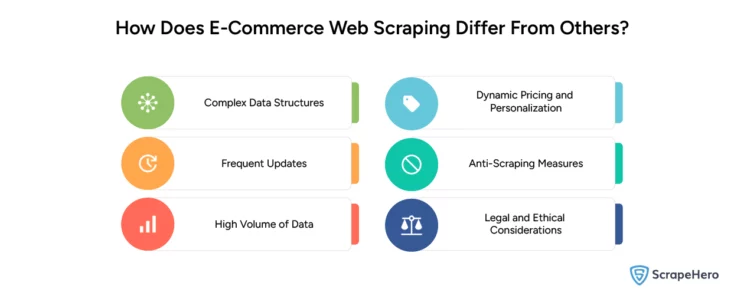
Complex Data Structures: E-commerce sites often have complex and dynamic data structures with multiple layers of product categories, extensive product listings, and varied pricing information. This complexity requires more sophisticated scraping techniques compared to more straightforward content on other websites.
Frequent Updates: E-commerce platforms regularly update product information, prices, and availability.
High Volume of Data: E-commerce websites typically have a vast amount of data, including thousands of product listings, each with its own set of attributes like descriptions, reviews, and images. Scraping this volume of data demands robust and scalable solutions.
Dynamic Pricing and Personalization: Many e-commerce sites use dynamic pricing models and content personalization based on user behavior and other factors. This can make it challenging to scrape consistent data, as the information displayed might change based on various parameters.
Stringent Anti-Scraping Measures: E-commerce sites often employ stronger anti-scraping measures than other websites. This includes captchas, IP blocking, and more sophisticated detection of scraping bots, necessitating more advanced techniques to circumvent these barriers.
Legal and Ethical Considerations: E-commerce data scraping must be particularly mindful of legal and ethical considerations, given the commercial nature of the data and the potential for competitive sensitivity. It is important to stay within the guidelines outlined in the robots.txt file and stick to scraping publicly available data.
What Data Can Be Scraped From an E-Commerce Website?
When scraping e-commerce websites, it’s essential to understand what kind of data you can extract. This data, invaluable for market analysis and strategic planning, can be grouped into several key categories:
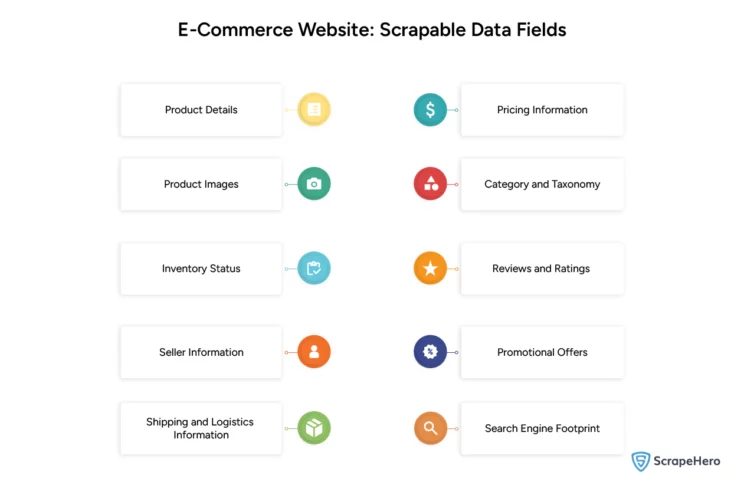
Product Details
- Name: The name or title of the product.
- Description: Detailed information about the product.
- Specifications: Technical details, sizes, materials, etc.
Pricing Information
- Retail Price: The listed price of the product.
- Discounted Price: Any ongoing sale or discounted prices.
Product Images
- Main Image: The primary image of the product.
- Gallery Images: Additional images showcasing different angles or features.
Category and Taxonomy
- Main Category: The primary category under which the product is listed.
- Subcategories: Any subcategories or tags associated with the product.
Inventory Status
- Stock Availability: Information on whether the product is in stock.
- Quantity Available: Number of items available, if listed.
Reviews and Ratings
- Customer Reviews: Text of customer reviews and feedback.
- Ratings: Average ratings and number of reviews.
Seller Information
- Seller Name: Name of the vendor or manufacturer.
- Seller Rating: Ratings or feedback specific to the seller.
Shipping and Logistics Information
- Shipping Costs: Fees associated with product shipping.
- Shipping Regions: Areas where the product can be shipped.
- Estimated Delivery: Timeframes for product delivery.
- Delivery Options: How the product gets to the customer.
Promotional Offers
- Coupons: Any available coupon codes or discounts.
- Special Offers: Limited-time offers or promotions related to the product.
Search Engine Footprint
- SEO Metadata: Clues on how e-commerce platforms optimize for visibility.
How Can the Data Obtained by Scraping E-Commerce Websites Be Used To Boost Your Business?
Web scraping is not just a tool for data collection; it presents you with a goldmine of opportunities. The data obtained from e-commerce websites can be analyzed to gauge your competitors and the market. This will further help you make actionable strategies, giving you a competitive edge in the marketplace.
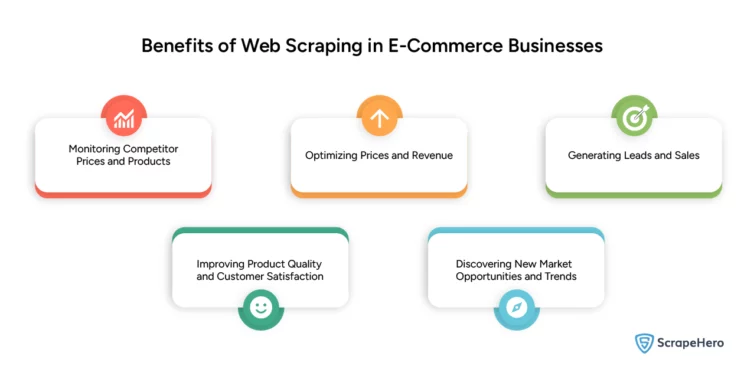
Monitoring Competitor Prices and Products by Scraping E-Commerce Websites
Staying informed about competitors’ pricing and product strategies is crucial for maintaining a competitive edge in the e-commerce business. By web scraping, businesses can systematically gather and analyze data from e-commerce websites to monitor how competitors are pricing and presenting their products.
Understanding the Importance of Price and Product Monitoring
- Market Trends: Prices and product offerings continuously evolve in the e-commerce industry. Keeping track of these changes is essential for any business aiming to stay relevant and competitive.
- Strategic Pricing: Businesses can strategically position their pricing by monitoring competitor prices. This could mean offering more competitive rates, matching market prices, or identifying opportunities for premium pricing.
Data Fields to Focus on While Scraping
- Product Prices: Regularly scraping competitors’ prices provides insights into their pricing strategy and market positioning.
- Product Descriptions and Features: Analyzing how competitors describe and feature their products can reveal market trends and customer preferences.
- Customer Ratings and Reviews: Gathering data on customer feedback can highlight the strengths and weaknesses in competitors’ products.
Utilizing Scraped Data for Business Strategy
- Dynamic Pricing Models: Competitor price data can be used to implement dynamic pricing models that adjust in response to market conditions.
- Product Optimization: Competitor product offerings and customer feedback can be analyzed to refine and enhance your own product range.
- Market Positioning: Your products and prices can be positioned in a way that fills gaps left by competitors, appealing to underserved market segments.
Optimizing Pricing and Revenue by Scraping E-Commerce Websites
With the advent of web scraping technologies, businesses can now optimize their pricing strategies and enhance revenue by using the data obtained from e-commerce websites.
Significance of Pricing in E-Commerce
- Direct Impact on Sales: Pricing is one of the most significant determinants of sales and profitability in e-commerce. It directly influences consumer buying decisions and brand perception.
- Dynamic Pricing Necessity: The e-commerce market is characterized by rapid fluctuations. Dynamic pricing allows businesses to adjust prices in real-time in response to market demands and competitor actions.
Key Data Points for Scraping
- Competitor Prices: Tracking competitors’ pricing strategies provides insights into market standards and consumer acceptance levels.
- Market Demand Patterns: Understanding demand trends helps in setting prices that capitalize on market opportunities.
- Consumer Behavior and Preferences: Data on consumer buying patterns and preferences aids in aligning prices with what customers are willing to pay.
Utilizing Scraped Data for Pricing Strategies
- Dynamic Pricing Implementation: Employing dynamic pricing models enables businesses to adjust prices in real-time based on market data, maximizing profitability.
- Promotional and Discount Strategies: Analyzing market and competitor data helps in strategizing effective promotions and discounts to attract customers without eroding profit margins.
- Predictive Analytics for Future Trends: Using scraped data for predictive analysis can anticipate future market trends and consumer behaviors, allowing businesses to proactively adjust their pricing strategies.
- Integration with Other Business Functions: Combining pricing data with other business functions, like inventory management and customer relationship management, for a holistic business strategy.
Say Goodbye to Guesswork!

Generating Leads and Sales by Scraping E-Commerce Websites
Generating leads and boosting sales in the e-commerce sector can be significantly enhanced by scraping e-commerce websites. This process involves systematically collecting data from various online retail platforms and analyzing it to gain insights that can inform and refine marketing and sales strategies.
Importance of Data-Driven Lead Generation
- Targeted Marketing: In the crowded online marketplace, reaching the right audience with the right message is crucial. Data-driven strategies ensure that marketing efforts are targeted and effective.
- Sales Optimization: By understanding market trends and consumer behavior, businesses can optimize their sales approaches, offering products and services that meet current demand.
Essential Data for Scraping
- Consumer Behavior and Trends: Information on what consumers are searching for, their buying patterns, and preferences.
- Competitor Product Listings and Promotions: Insights into competitors’ product offerings, promotional strategies, and customer engagement tactics.
- Pricing Strategies and Sales Events: Data on how pricing affects purchase decisions and the impact of sales or discount events.
Applying Scraped Data to Boost Leads and Sales
- Tailored Marketing Campaigns: Consumer behavior data can be used to create personalized and targeted marketing campaigns that resonate with potential customers.
- Product Strategy Adjustments: Product offerings can be aligned with market demands and trends identified through competitor analysis and consumer preferences.
- Pricing and Promotion Strategies: Pricing and promotional efforts can be optimized based on insights into what drives consumer purchases.
- Increased Conversion Rates: By understanding and responding to consumer needs, businesses can increase conversion rates and customer acquisition.
- Enhanced Customer Engagement: Data-driven strategies lead to more effective and engaging interactions with potential and existing customers.
Improving Product Quality and Customer Satisfaction by Scraping E-Commerce Websites
By collecting and analyzing data from various e-commerce platforms, companies can gain insights that improve product quality and customer experiences.
The Role of Quality and Satisfaction in E-Commerce
- Customer Retention: High-quality products and positive customer experiences are key to retaining customers and building brand loyalty.
- Competitive Advantage: In a market where consumers have ample choices, superior product quality and customer satisfaction can differentiate a brand from its competitors.
Critical Data Points for Scraping
- Customer Reviews and Feedback: Collecting data on customer opinions, complaints, and suggestions.
- Return and Complaint Rates: Understanding the reasons behind product returns and customer complaints.
- Competitor Product Information: Analyzing how competitors’ products are received by the market.
Utilizing Scraped Data for Product and Service Improvement
- Enhancing Product Features: Customer feedback can be used to identify and implement improvements in product design and functionality.
- Addressing Customer Pain Points: Recognizing and resolving common issues or complaints highlighted in customer feedback.
- Benchmarking Against Competitors: Comparing products with competitors to understand areas of improvement.
- Increased Customer Loyalty: Improved product quality and customer satisfaction lead to higher customer retention rates.
- Positive Brand Image: Delivering high-quality products and excellent customer service enhances the overall brand image and reputation.
Discovering New Market Opportunities and Trends by Scraping E-Commerce Websites
The data gathered through web scraping can be analyzed to provide insights into new trends, customer preferences, and untapped market segments.
Significance of Identifying Market Opportunities and Trends
- Staying Competitive: In an ever-changing market, being aware of and responding to new trends is crucial for maintaining competitiveness.
- Growth and Expansion: Identifying new market opportunities is key to business growth and expansion into new segments or regions.
Key Data for Scraping
- Emerging Product Categories: Analyzing data on newly listed products and categories that are gaining popularity.
- Consumer Search and Purchase Patterns: Understanding what consumers are searching for and buying, indicating shifts in preferences and needs.
- Regional Market Variations: Identifying geographical differences in consumer behavior and product popularity.
Using Scraped Data to Identify Opportunities
- Analyzing Consumer Trends: Examining consumer behavior data to spot emerging trends in preferences and demands.
- Market Gap Analysis: Identifying gaps in the market where consumer needs are not being fully met.
- Competitor Benchmarking: Comparing your offerings with competitors to find areas for differentiation and innovation.
- Informed Decision Making: Data-driven insights guide strategic decisions in product development, marketing, and expansion.
- Innovation and Adaptation: Staying ahead of market trends allows for innovation and quick adaptation to changing consumer needs.
Legal and Ethical Considerations When Scraping an E-Commerce Website
When it comes to web scraping an e-commerce website, there are important legal and ethical considerations to remember. By adhering to legal and ethical considerations, you can engage in web scraping for e-commerce websites responsibly and effectively.
- Check the website’s terms and conditions: Some websites may explicitly prohibit scraping in their terms of use. Therefore, it is crucial to read and understand the website’s policies before scraping.
- Respect data privacy laws: It is important to collect only publicly available data and avoid scraping any personal or sensitive information. Make sure to comply with relevant data privacy laws.
- Use selective scraping: Instead of scraping the entire website, focus on specific pages or sections relevant to the business’s objectives. This can help to minimize the risk of overloading the website’s server.
- Handle rate limits and IP blocking: E-commerce websites may have rate limits and may block IP addresses that exceed these limits. It is important to respect these limits and avoid causing any damage to the website’s server.
Why You Need a Web Scraping Service Provider Over an In-House Team
While building an in-house team for web scraping might seem like a viable option, there are compelling reasons why outsourcing to a dedicated service provider is more advantageous for businesses.
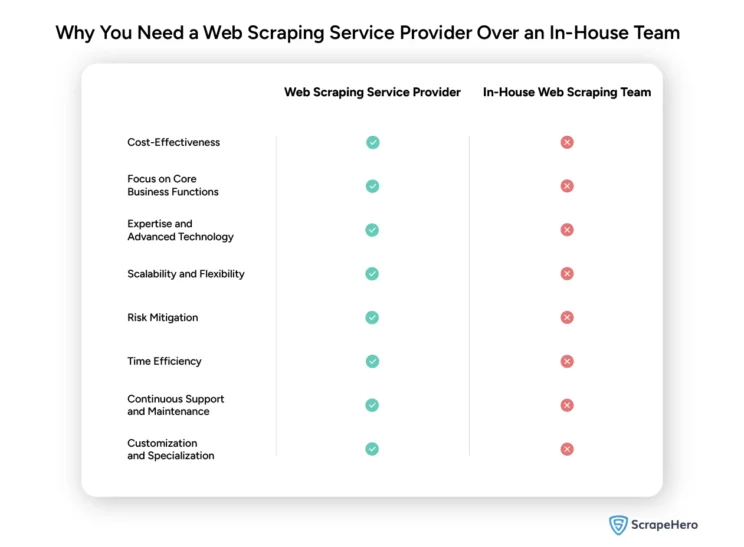
Cost-Effectiveness
Setting up an in-house scraping team entails significant upfront costs, including hiring expert staff, purchasing software, and maintaining infrastructure. Outsourcing to a web scraping service provider, on the other hand, dramatically reduces these expenses. Service providers have the necessary technology and skilled personnel in place, allowing businesses to utilize these resources at a fraction of the cost of maintaining an in-house team.
Focus on Core Business Functions
By outsourcing web scraping, companies can concentrate on their core business activities without being sidetracked by the complexities of data extraction. This allows businesses to allocate their time, resources, and efforts toward areas where they excel, thus enhancing productivity and efficiency.
Access to Expertise and Advanced Technology
Professional web scraping service provider bring with them the experience and access to cutting-edge technology. These providers stay abreast of the latest trends, legalities, and best practices in data extraction, ensuring that businesses receive high-quality, accurate, and legally compliant data.
Scalability and Flexibility
Outsourced web scraping service providers offer scalability that is difficult to achieve with an in-house team. Whether a business needs to ramp up its data collection efforts or scale them down, a service provider can easily adjust to these changing demands without disrupting the business’s regular operations.
Risk Mitigation
Web scraping comes with its own set of legal and ethical considerations. Service providers are adept at navigating these complexities, significantly reducing business risk. They ensure compliance with legal standards, mitigating potential legal issues arising from improper data scraping practices.
Time Efficiency
Setting up an in-house scraping operation is time-consuming, from recruiting the right talent to setting up the necessary infrastructure. An external scraping service, with its established setup, can start delivering results almost immediately, saving valuable time for businesses.
Continuous Support and Maintenance
Web scraping services provide ongoing support and maintenance, ensuring that the data extraction process runs smoothly at all times. This includes regular updates, troubleshooting, and adapting to any changes in source websites, which an in-house team might struggle to keep up with.
Customization and Specialization
Professional web scraping service providers offer a high degree of customization to meet specific business needs. Whether it’s specific data points, formats, or frequencies of updates, these services can tailor their offerings to suit unique business requirements, which is often challenging for in-house teams to achieve with limited resources.
While the allure of managing an in-house web scraping team can be strong, the advantages of partnering with an expert external web scraping service provider are undeniable. The scalability, flexibility, and risk mitigation offered by professional services like ScrapeHero ensures that your data needs are met efficiently and effectively without the time-consuming challenges of managing an internal team.
Moreover, the continuous support, customization, and specialization that ScrapeHero provides make it an invaluable partner for businesses looking to utilize the power of web scraping without the complexities and overhead of in-house operations.
How to Choose the Best E-Commerce Web Scraping Service Provider?
Selecting the right e-commerce web scraping service provider can be a game-changer for your business. It’s crucial to make an informed decision.
- Research and Understand Your Needs: Before selecting a web scraping service provider, identify your specific requirements. Determine the type of data you need to scrape from e-commerce websites, such as product information, pricing, reviews, or competitor data.
- Check Website Terms and Conditions: Ensure that the web scraping service you choose adheres to the terms and conditions of the e-commerce websites you plan to scrape. Respect their policies regarding data usage and scraping.
- Ensure Legal and Ethical Compliance: Familiarize yourself with data privacy laws and regulations in your jurisdiction. Choose a web scraping service that respects these laws and practices transparency in data handling.
- Evaluate Service Quality: Look for a web scraping service that offers reliable and secure scraping capabilities. Consider factors such as the quality of data delivered, scalability, and the ability to handle web scraping challenges.
- Consider Pricing and Customer Service: Transparency in pricing is essential. Choose a web scraping service that offers competitive pricing models and good customer service. This ensures a smooth and satisfactory experience.
- Check Data Accuracy and Timeliness: The data scraped should be accurate and delivered in a timely manner. Choose a web scraping service that guarantees high-quality and up-to-date data.
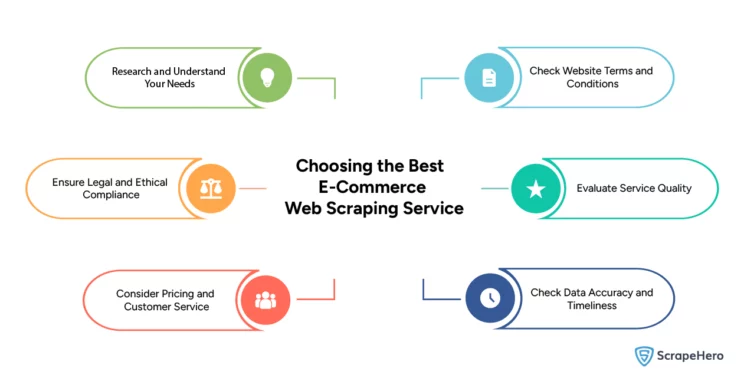
The right e-commerce web scraping service can unlock new opportunities and insights for your business. Services like ScrapeHero offer a blend of accuracy, scalability, user-friendliness, and legal compliance, making them an excellent choice for businesses seeking to leverage the power of web scraping in the e-commerce sector.
Conclusion: Navigating the Web Scraping Revolution in E-Commerce
Web scraping is more than just a technical process; it’s a strategic tool that empowers businesses to make data-driven decisions. Whether it’s about adjusting pricing strategies, understanding customer sentiment, or anticipating market changes, the insights gained through web scraping are invaluable. In the dynamic world of e-commerce, staying informed and ahead of the curve is not just beneficial—it’s essential.
As we’ve seen, choosing the right e-commerce web crawling service is a critical decision. It involves understanding your specific needs, evaluating service quality, ensuring legal compliance, and considering scalability and customer support. ScrapeHero, with our focus on accuracy, scalability, and user-friendliness, emerges as a comprehensive solution for businesses diving into the world of e-commerce web scraping.
Ready to transform your e-commerce strategy with data-driven decisions? Discover how ScrapeHero can empower your business in the ever-changing digital marketplace.

